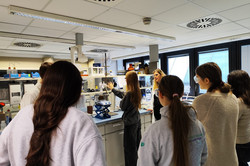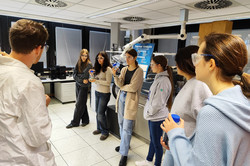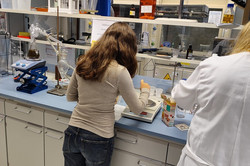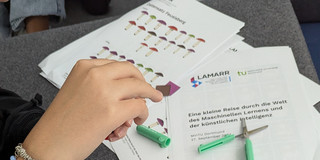Schoolgirls research the Möbius strip
- MinTU

The workshop in the Department of Biological and Chemical Engineering started with a welcome lecture, during which the MinTU participants learned a lot about studying, the prospects after graduation and the differences between the individual disciplines. At the end of the lecture, there was a short quiz that challenged everyone. However, research and experimentation were the main components of the workshop. Equipped with lab coats and safety goggles, the participants used so-called superabsorbents to learn why diapers hold tight and how much water they can hold. They were surprised to learn that a diaper can actually absorb up to 150 times its own weight in liquid.
In keeping with the time of year when people tend to get sore throats, the girls then made their own peppermint pastilles. From extracting the peppermint oil to weighing the ingredients and pressing the pastilles, they were able to carry out all the steps of the production process themselves, taste the resulting pastilles and take them home with them.
Finally, they learned how nylon is made from two different chemicals and were allowed to make a milk glue from milk and vinegar. They experienced at first hand how chemistry can be used in everyday life.
To get to the mathematics workshop, the MinTU participants first climbed the so-called "Mathetower" of the Department of Mathematics. Once at the top, things got colorful. They learned why the four-color problem was one of the biggest puzzles in mathematics until just a few years ago and why it was the subject of heated debate for decades. The problem under consideration states that four colors are always sufficient to color any map in such a way that no two adjacent countries have the same color. Equipped with lots of pencils, the participants tested this statement.
The workshop also focused on the Möbius strip with its amazing properties. The tape has only one surface, which has only one edge and one side. You cannot distinguish between the bottom and top or between the inside and outside. The girls investigated this phenomenon by trying to divide the ribbon along the longitudinal center line, for example. This task was not only creative, but also a great example of "hands-on math".
Finally, the participants were able to try their hand at tasks from the well-known kangaroo math competition. The tricky questions got everyone thinking and were a lot of fun at the same time.
The MinTU workshop day offered many exciting insights into scientific phenomena and the departments. It was the last MinTU workshop day for this year's participants. The MinTU year will start again in 2025 with a new round, for which applications are still open until December 31.






















